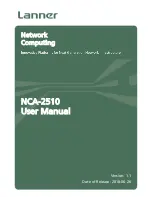
Chapter 10 Routing
ZyWALL ATP Series User’s Guide
300
10.1.2 What You Need to Know
Policy Routing
Traditionally, routing is based on the destination address only and the Zyxel Device takes the shortest
path to forward a packet. IP Policy Routing (IPPR) provides a mechanism to override the default routing
behavior and alter the packet forwarding based on the policy defined by the network administrator.
Policy-based routing is applied to incoming packets on a per interface basis, prior to the normal routing.
How You Can Use Policy Routing
• Source-Based Routing – Network administrators can use policy-based routing to direct traffic from
different users through different connections.
• Bandwidth Shaping – You can allocate bandwidth to traffic that matches routing policies and
prioritize traffic (however the application patrol’s bandwidth management is more flexible and
recommended for TCP and UDP traffic). You can also use policy routes to manage other types of
traffic (like ICMP traffic) and send traffic through VPN tunnels.
Note: Bandwidth management in policy routes has priority over application patrol bandwidth
management.
• Cost Savings – IPPR allows organizations to distribute interactive traffic on high-bandwidth, high-cost
paths while using low-cost paths for batch traffic.
• Load Sharing – Network administrators can use IPPR to distribute traffic among multiple paths.
• NAT - The Zyxel Device performs NAT by default for traffic going to or from the
WAN
interfaces. A
routing policy’s SNAT allows network administrators to have traffic received on a specified interface
use a specified IP address as the source IP address.
Note: The Zyxel Device automatically uses SNAT for traffic it routes from internal interfaces to
external interfaces. For example LAN to WAN traffic.
Static Routes
The Zyxel Device usually uses the default gateway to route outbound traffic from computers on the LAN
to the Internet. To have the Zyxel Device send data to devices not reachable through the default
gateway, use static routes. Configure static routes if you need to use RIP or OSPF to propagate the
routing information to other routers. See
for more on RIP and OSPF.
Policy Routes Versus Static Routes
• Policy routes are more flexible than static routes. You can select more criteria for the traffic to match
and can also use schedules, NAT, and bandwidth management.
• Policy routes are only used within the Zyxel Device itself. Static routes can be propagated to other
routers using RIP or OSPF.
• Policy routes take priority over static routes. If you need to use a routing policy on the Zyxel Device
and propagate it to other routers, you could configure a policy route and an equivalent static route.
DiffServ
QoS is used to prioritize source-to-destination traffic flows. All packets in the same flow are given the
same priority. CoS (class of service) is a way of managing traffic in a network by grouping similar types of












































